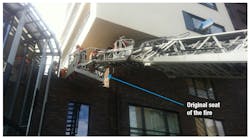International Exchange: Insulation Fire in Brussels
The Grenfell fire in London drew attention to the problem of combustible façades. Earlier fires in France and Dubai also led to spectacular fires, but with no or very limited loss of life.
On Nov. 3, 2015, construction workers accidently started a fire in the combustible insulation of a high-rise building in Brussels, Belgium. The Brussels Fire Department (BFD) managed to keep the fire in check and avoid the scenario of a rapid-spreading insulation fire.
Here we’ll review the Brussels fire to provide lessons learned for fire crews at these types of incidents.
The building
The building, located in the Evere municipality of Brussels, was a newly constructed high rise with 16 floor levels above ground. There was a small section of flat roof on the third floor, with a part of the building in cantilever above.
Situation upon arrival
The standard response for fire in Brussels is two engines, two trucks, one ambulance and one battalion chief. They respond from two stations: Schaarbeek and Helihaven.
Upon arrival, fire crews notice that the walls were partially covered with bricks and partially plastered. The composition of the wall was not clear at the start. It was assumed that the brick wall was traditional masonry.
The battalion chief had worked as a civil engineer before joining the fire service. A composition that he frequently used was (from inside to outside) insulation, concrete paneling, exterior plaster. He assumed that the plastered walls were insulated on the inside—an assumption that was consistent with his frame of reference.
Upon their arrival, the crews of Schaarbeek station were greeted by construction workers who had accidentally directed the flame of a blow torch up the brick wall. This caused the PUR insulation in the wall to burn. However, the outer brick layer was making it very hard for fresh air to reach the fire, causing a smoldering fire. The construction workers had emptied a dry chemical extinguisher in the cavity of the wall.
Crews set up a ladder truck and deployed a high-pressure booster line to flow water onto the wall and into the cavity to extinguish the fire.
Course of the incident
The battalion chief was briefed by the captain of Schaarbeek. He decided to call a heavy-rescue to create various holes in the brick wall. Next, piercing nozzles were inserted right up to the PUR insulation so that the fire could be extinguished.
The chief and the captain consulted the construction workers and the lieutenant in charge of the ladder truck. The fire seemed to have been extinguished. However, when taking a closer look with the thermal imaging camera (TIC), there was still heat being registered on the brick wall. The joints lit up again on the TIC followed by an entire section of bricks, indicating that the fire was still smoldering.
A crew was sent inside with a carbon monoxide (CO) meter, with instructions to check the apartments for smoke and perform CO measurements.
The incident commander (IC) was a bit worried that the fire would pass around the corner, so he took a closer look at the masonry, as the part where the rain pipe was fixed in the concrete overhang seemed to be a hotspot. The initial assumption about how the sections in plaster were made up turned out to be wrong.
The real buildup was as follows: exterior plaster, EPS insulation, concrete. When the plaster was removed around the rain pipe, the insulation was seen smoldering underneath. A lieutenant was then ordered to clear the section around the rain pipe with the goal of checking how far the fire had spread inside the insulation. Soot stains along with partially melted and discolored insulation showed that the fire had indeed spread.
The crew was asked to move five meters farther and make another cut in the insulation. Again, the fire had spread beyond this point.
The crew inside then reported that there was an odor of fire in the apartment located directly above the fire. Moreover, large amounts of soot were found on the wooden floor. This created the impression that the fire was still spreading.
The situation was as follows:
- Fire located in the vertical brick wall on the third floor (fire in a vertical pane).
- Fire spread to the insulation in the cantilever section (fire in a horizontal pane).
- Fire might have spread vertically and was now smoldering on the fourth floor.
- Fire in the overhang had passed the corner of the building and was spreading horizontally.
The fire was progressing slowly but steadily, and it was unclear how far it had spread. The fire had started in a single vertical wall section and was now in the horizontal pane under the overhang. Moreover, the fire had passed the corner inside the brick wall, creating a smoldering fire in a second vertical pane. A very clear distinction had to be made between a smoldering fire in a vertical pane and in a horizontal pane. After all, the fire would spread much quicker upward than sideways. At this point, crews were worried that the fire would reach the edge of the overhang and start travelling upward again, which could lead to grave consequences.
A third ladder truck was called to speed operations. Crews knew that the fire must not be allowed to reach the border between the horizontal and vertical sections.
The strategy was to remove the fuel and extinguish/remove the burning bits. Like in forest firefighting, “firebreaks” were created in the plastered sections by making saw cuts and removing the insulation.
Crews checked whether the edges of the cuts consisted of unburnt material. If they did, then the firefighters would be certain that the fire has been cut off. Aside from outlining the fire in the plaster wall section, the brick section was taken care of by drilling holes in several places and inserting a piercing nozzle.
To achieve the goals set by the strategy, three crews were operating simultaneously. Crews ultimately succeeded in quickly removing enough insulation to outline the fire.
Final damage
The final damage was relatively limited. The brick wall had been punctured in about a dozen places. In the plastered sections, there was substantially more damage. The bottom side of the overhang needed to be replaced almost entirely. The last photo indicates the fire’s reach. Crews halted the fire at about 20 to 30 cm from the edge of the overhang.
About the Author

Karel Lambert
Karel Lambert is a battalion chief with the Brussels Fire Department and a leading firefighter (volunteer) in his home town. He is an internationally recognized instructor and participated in training programs in 14 countries. Lambert has master’s degrees in civil engineering, occupational safety and health, and fire safety engineering. He is also a guest professor within Ghent University. Lambert is a co-author of two books and has written numerous articles about firefighting.
